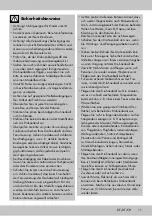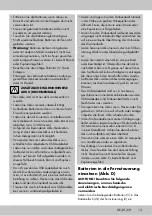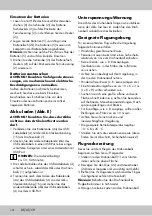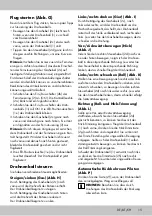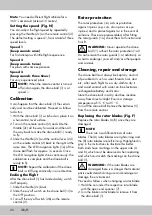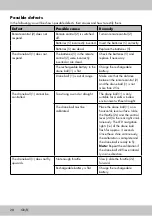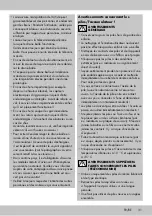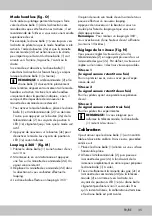
25
GB/IE
Controlling the drone ball
You have several controlling options:
Rising/sinking (throttle) (Fig. H)
By pressing the throttle (2c) forwards, the rotation-
al speed of the rotors is increased. The drone ball
begins to rise.
By pressing the throttle back, the rotational speed
of the rotors is reduced.
The drone ball begins to sink.
Turning left/right (yaw) (Fig. I)
By moving the throttle (2c) to the left or right, the
drone ball is turned on its vertical axis, that means
the drone ball rotates to the right or left staying in
the same spot. The farther you move the throttle,
the faster the rotation.
Moving forwards/backwards (pitch)
(Fig. J)
By moving the right control lever (2d) to the front
or back, the drone ball tends in the corresponding
direction. The farther you steer the control lever in
the appropriate direction, the faster the drone ball
will fly.
Hover left/right (roll) (Fig. K)
If you want to perform a movement to the right
or left without rotating the drone ball, i.e. hover
sideways, then move the right control lever (2d) to
the left or right. The farther you steer the control
lever, the faster the sideways movement.
Direction (roll and pitch trim) (Fig. L)
If there is a forwards or backwards movement,
even though you are not using the control lever
(2d) at all, you can correct this with the pitch trim.
If the drone ball (1) flies forwards, press the pitch-
trim button (2g) backwards and vice versa. You
counteract the unwanted movement with the trim
setting. If the drone ball (1) moves sideways inde-
pendently, you can correct this with the roll trim.
If the drone ball (1) hovers sideways to the left,
then press the trim button (2h) to the right and
vice versa. Thus you counteract the unwanted
movement.
Automatic return to the pilot (Fig. P)
Press the button (2f) if the drone ball is to fly back
the route covered.
NOTE:
Remember that the return route can
deviate due to rotation of the drone ball.
Headless mode (Fig. O)
This refers to a flight aid, that when activated lets
the drone ball (1) always fly in the direction it is
steered. It is recommended when the pilot has little
flying experience.
When the button (2e) of the headless mode is
activated, the drone ball (1) when viewed from
the pilot, always flies to the right, when the control
lever (2d) is steered to the right, regardless of
whether the front of the drone ball (1) is facing
behind, left, in front, or right.
If this mode is deactivated, the drone ball (1) flies
in the direction in which its front side faces (even if
the drone ball (1) has rotated).
NOTE:
The remote control (2) and the
drone ball (1) must be oriented exactly the
same when activating the headless mode! Only
activate the headless mode in the position
specified, otherwise it may result in control
commands not being carried out correctly.
1. To activate the headless mode, put the drone
ball (1) and the remote control (2) one behind
the other and press the button (2e) on the re-
mote control (2). The LED navigation lights (1e)
flash while the mode is active.
2. To deactivate the mode, press the button (2e)
again. The LED navigation lights (1e) shine
continuously again.
360° somersault (Fig. M)
1. Guide the drone ball (1) to a height of about
10m.
2. Keep it hovering and press the control lever
once (2d). A beep sounds.
3. Move the control lever (2d) in the direction in
which the somersault is to be flown.
4. The drone ball performs a 360° somersault.
After the somersault, the drone ball is in normal
flight mode and you can repeat another somer-
sault.
Press the button again if you do not want to do a
somersault and have already pressed it.

